Conny Waters – AncientPages.com – A large, complex karst cave known as the Te’omim Cave located in the Jerusalem Hills has been excavated since 2009 by a team of archaeologists from Bar-Ilan University and the Cave Research Center at the Hebrew University of Jerusalem.
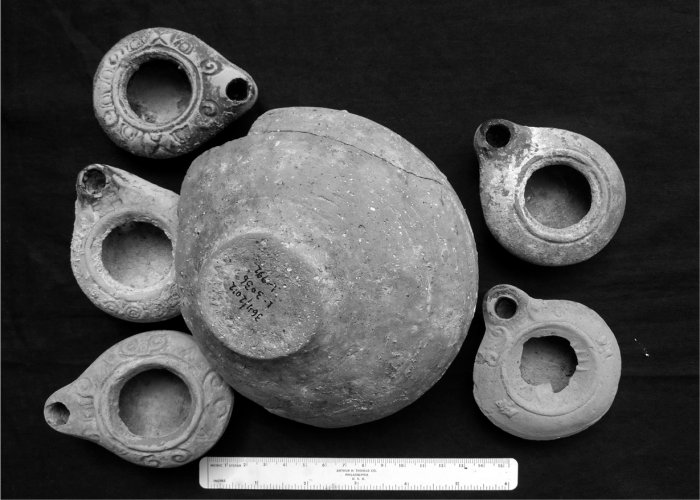
Finds from L. 3036: Three oil lamps (left) were found underneath the MBII bowl, and two oil lamps (right) had been placed near it (pH๏τo: B. Zissu under the Te’omim Cave Archaeological Project)
A large collection of oil lamps and coins from the Late Roman period, as well as pottery and other items from the Byzantine period, was discovered in the main chamber and its ramifications.
About 120 well-preserved and intact oil lamps dating to the Late Roman and Early Byzantine periods (late second to fourth centuries CE) were collected from cavities and crevices in the cave. The lamps – discovered in the cave during the 2010–2016 survey seasons – had been “deliberately inserted in narrow, deep crevices in the main chamber walls or beneath the rubble,” the archaeologists write in their paper.
Most of the lamps were accessible only by difficult crawling.
According to achaeologists, illuminating the dark cave was not their sole purpose for using these oil lamps as they were found buried deep in hidden, hard-to-reach crevices.
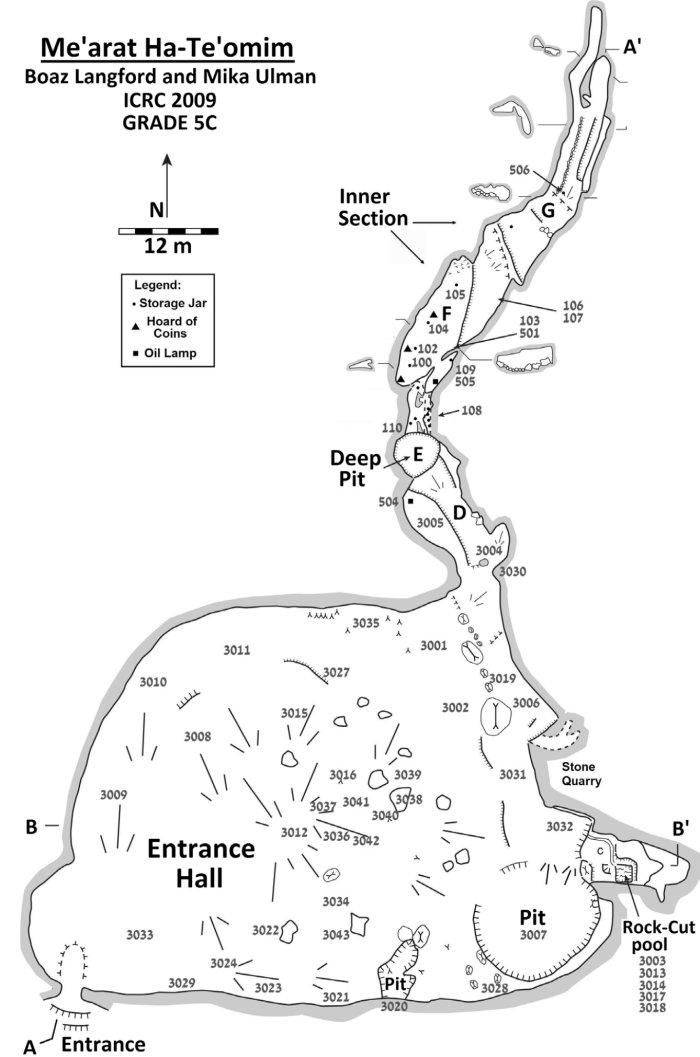
Plan of the Te’omim Cave (B. Langford, M. Ullman under the Te’omim Cave Archaeological Project)
Is it possible that all the oil lamps, human skulls, weapons, and pottery vessels, (even from earlier periods), were used as part of necromancy rituals that took place in the cave during the Late Roman period?
Did the Te’omim Cave serve as a local oracle (nekyomanteion)?
The cave was explored in the late 1920s and later from 1970 to 1974 and excavations revealed ceramic, woode,n and stone vessels dated to the Neolithic and Chalcolithic periods, the Early Bronze, Middle Bronze, and Iron Ages, and the Roman and Byzantine periods
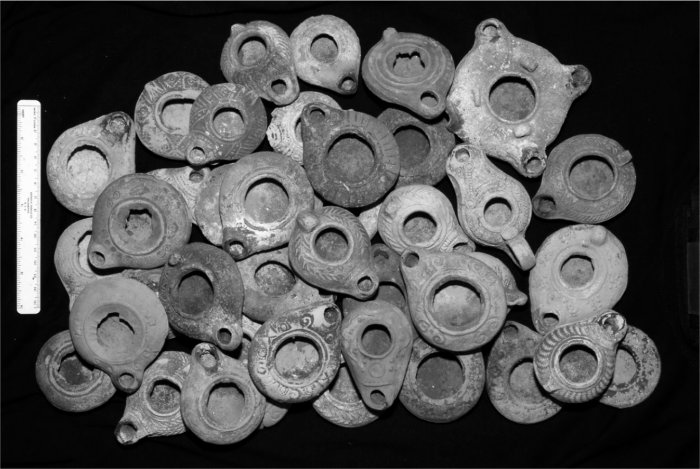
Group of intact oil lamps discovered in the Te’omim Cave (mostly in L. 3036) in the 2012 season (pH๏τo: B. Zissu under the Te’omim Cave Archaeological Project)
During the recent explorations , the archaeologists uncovered different finds from numerous periods, ranging from the Neolithic period to the present. The three main periods are: the Middle Bronze Age (ca. 2000–1550 BCE), the end of the Bar Kokhba revolt (ca. 132–136 CE), and the Late Roman–Early Byzantine period (late 2nd to 4th centuries CE).
The present study focuses on the Late Roman–Early Byzantine phase in the Te’omim Cave.
Beginning in the late second century CE, the cave—especially its deep pit and interior spring – functioned as a place of devotion.
In previous studies, researchers suggested that the cave was consecrated to a chthonic (underworld) deity.
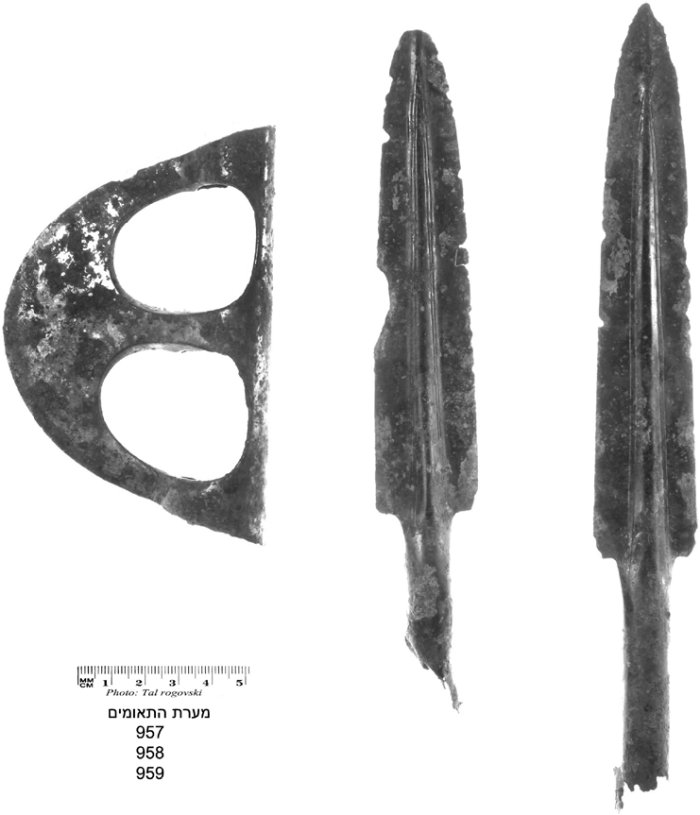
PH๏τo of three bronze objects (an “eye axe” and two socketed spearheads) (pH๏τo: Tal Rogovski under the Te’omim Cave Archaeological Project)
“During the survey of the cave, three human craniums were found inside hard-to-reach crevices and beneath large rocks in the central chamber. However, no additional human bones were found with the craniums. Because two of the craniums were discovered in crevices and with no other finds nearby, we initially believed that they had been moved there by rats after having originally been placed elsewhere,” according to the paper.
The third cranium was found in situ in a hard-to-reach crevice, covering four ceramic oil lamps of local types typical of the third and fourth centuries CE This find supports the possibility that the cranium’s location is not a coincidence.
The craniums and lamps seem to have been placed there together deliberately, in one time period—namely, the Late Roman period—and to have served a single purpose for whomever put them there.
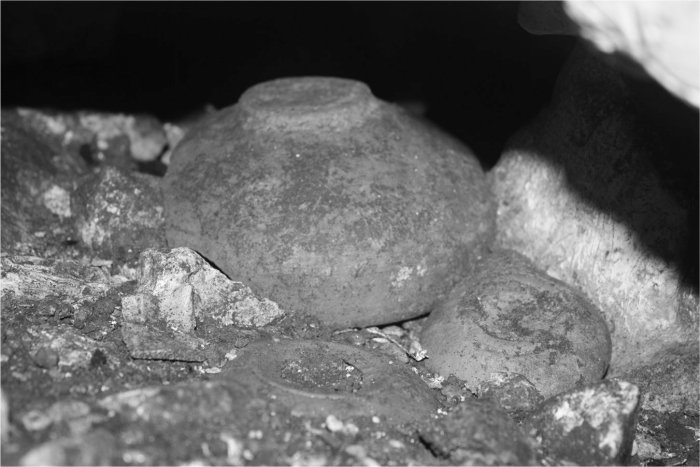
Oil lamps and a MBII bowl in situ in crevice L. 3036 (pH๏τo: B. Langford under the Te’omim Cave Archaeological Project)
Based on the discoveries made in the cave, the researchers believe that the craniums were placed together with the oil lamps as part of a ritual of magic, conducted in the cave in that period. Also examination of both the written sources and the archaeological finds may indicate the type of ritual that took place in the cave, involving the use and hiding of human craniums, lamps, and bowls, together with metal weapons and other artifacts dating to much earlier periods.
Identifying magical practices in the archaeological evidence is not simple.
Magical practice is used in ritual acts that are undertaken, mainly by individuals, to achieve a desired effect.
The ancient shrines and rites are hard to identify with certainty. Necromancy was accepted in the Levant and the ancient East. There are many references to it in the Bible, such as the story of Saul having the prophet Samuel conjured up at Ein Dor (1 Sam 28:7–24).
However,the act was viewed negatively, as adoption of the customs of the surrounding nations, and was therefore punishable by death.
The study summarizes that despite hints that the practice existed to a limited extent even among the Jewish population, we suggest that the participants in the cult in the cave were mainly non-Jewish residents of the area.
To sum up, the identification of the Te’omim Cave as a local oracle (nekyomanteion) and the analysis of the archaeological ᴀssemblage is in our opinion an outstanding test case worth examining within the developing discipline of the “archaeology of magic.”
The findings and their specific archaeological contexts provide a better understanding of divination rites that were probably held in the cave and shed a more tangible light over the spells of the Greek and Demotic Magical Papyri.
————————-
Eitan Klein and Boaz Zissu – “Oil Lamps, Spearheads and Skulls: Possible Evidence of Necromancy during Late Antiquity in the Te’omim Cave, Judean Hills” Harvard Theological Review , Volume 116 , Issue 3 , July 2023 , pp. 399 – 421 DOI: https://doi.org/10.1017/S0017816023000214
Written by Conny Waters – AncientPages.com Staff Writer





